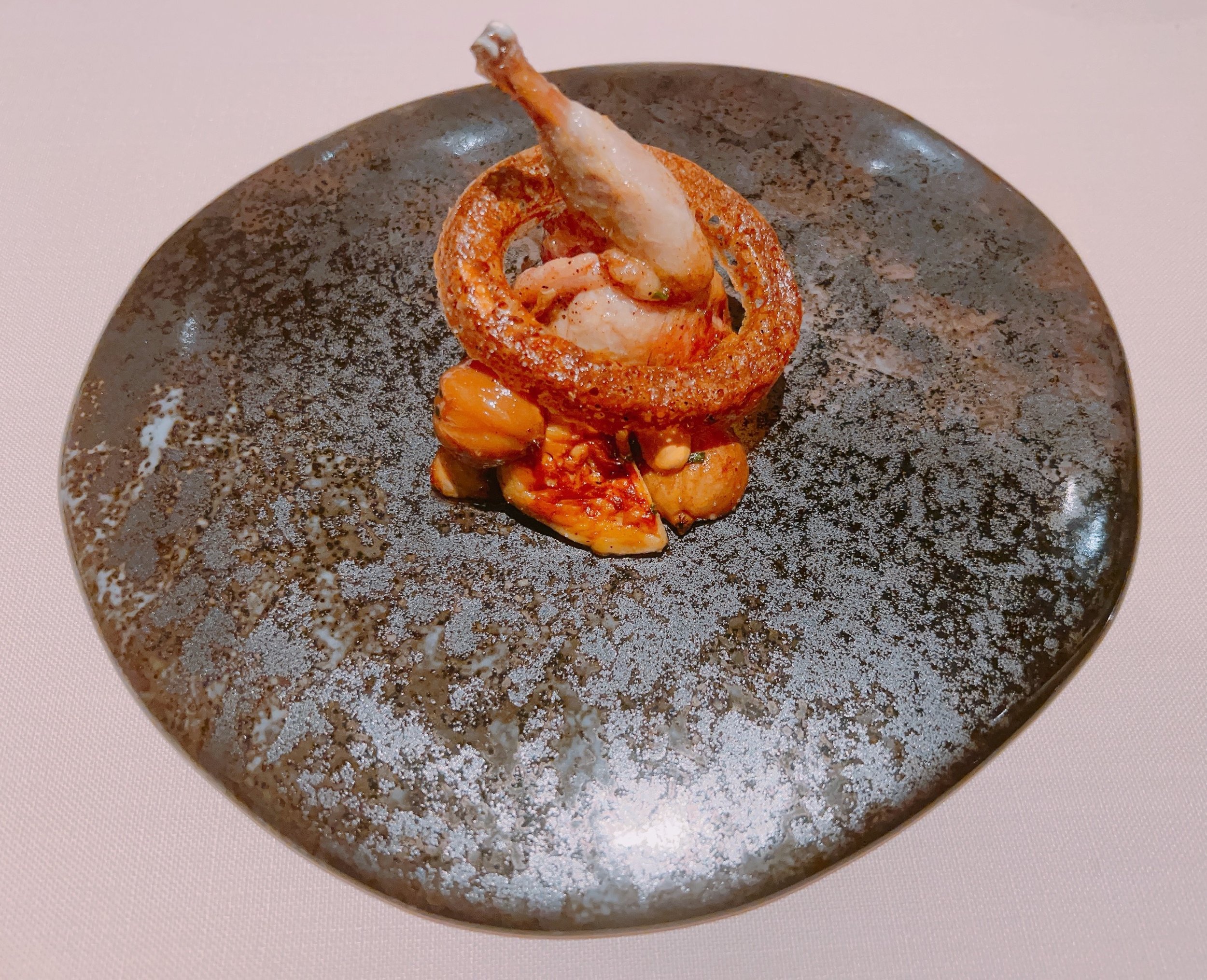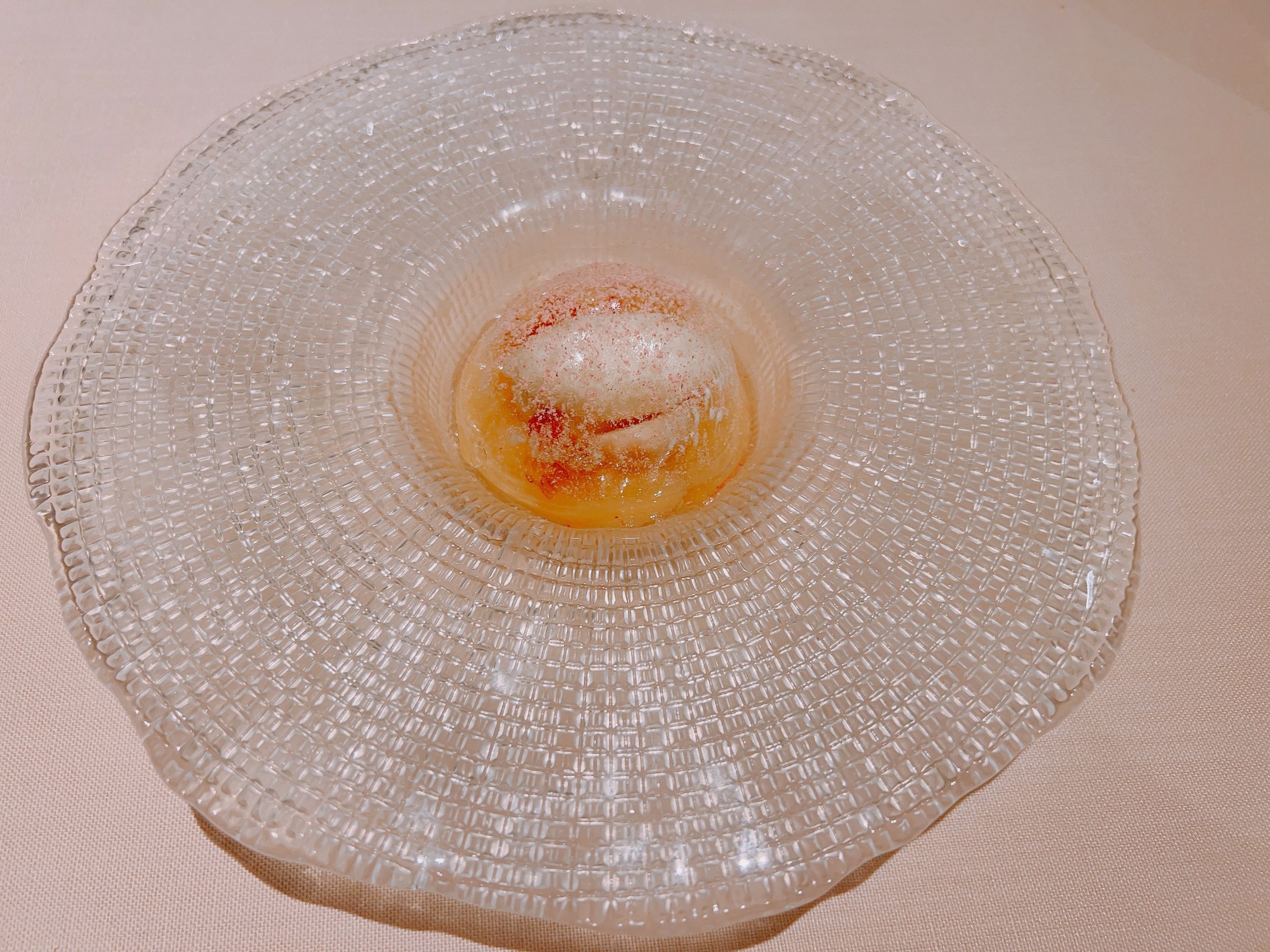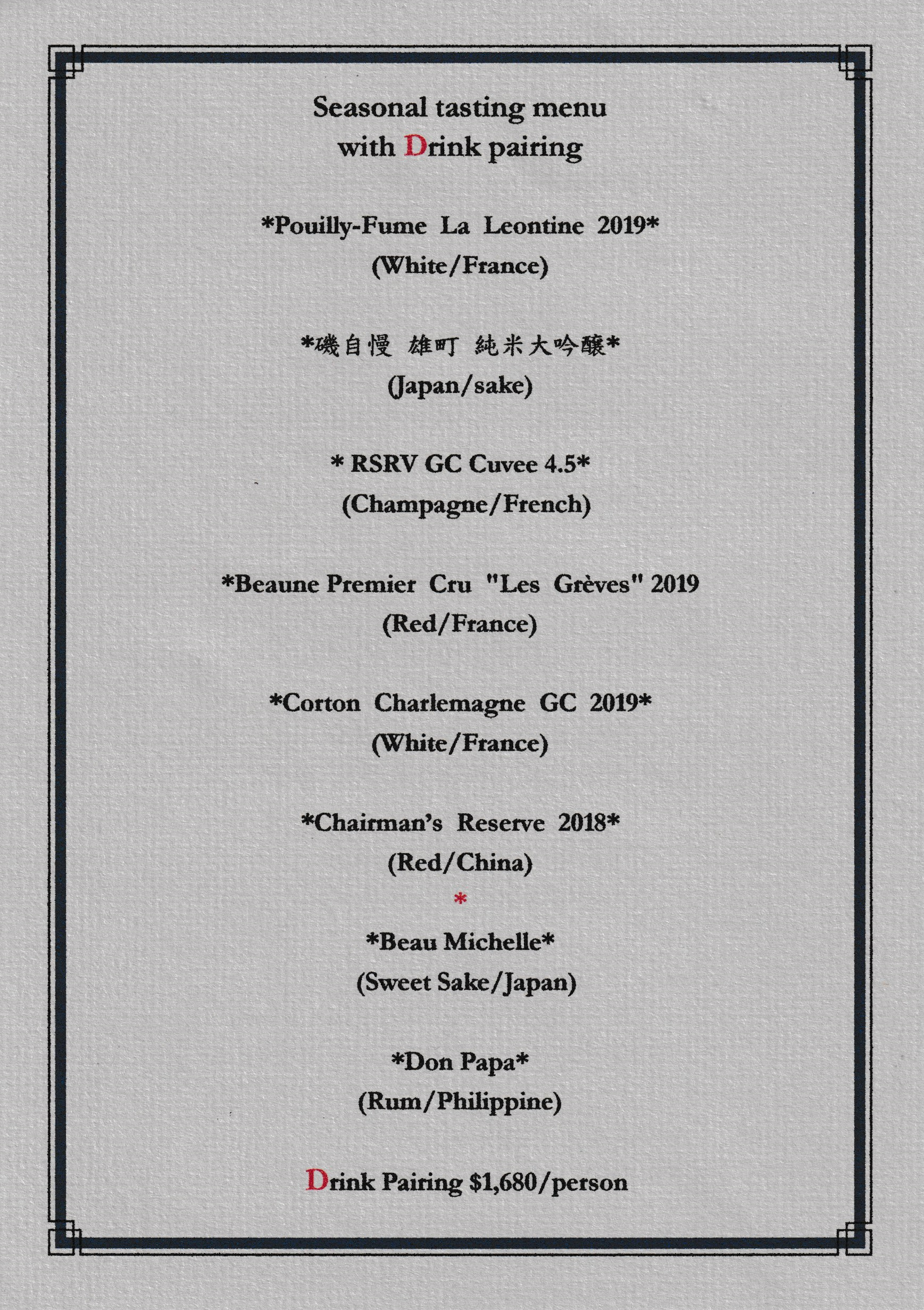Ta Vie - Hong Kong
Rating: 18/20
Where: Hong Kong, Hong Kong
When: Dinner for 2 on 27 July 2023
Cost per Person: Tasting menu 2980 HKD, Wine pairing 1680 HKD
Accolades: 3 Michelin Stars
Why: Successful combination of French Mediterranean cuisine and Japanese influences
“Ta Vie” is a three Michelin starred restaurant in Hong Kong's Central district, located on the second floor of the Pottinger hotel. Its Japanese chef serves French cuisine, but with many ingredients (and even some wines) sourced from Asia. Like many French restaurants in Japan, the chef gives the food a personal twist, and it ends up being quite different from what one might encounter in Paris.
Even though situated inside a hotel, Ta Vie doesn't feel much like a typical hotel restaurant. The host stand is next to the elevator on the second floor, and from there we were led though a long, narrow dining room. Tables were spaced out along this corridor, which ended with two tables (one of them semi-private) next to the windows overlooking Queen’s Road. These two are probably the best tables in the house, with a view of the busy street below.
The dominant color of the interior is black, which - with the mostly closed blinds - might suggest a somewhat subdued atmosphere. But luckily, the staff was extremely friendly, with everyone (naturally) speaking perfect English. We only saw two servers who, along with the chef himself, handled the service for all tables. I have never seen a three-starred chef bus tables and explain every other dish in person - he came across as approachable and refreshingly unpretentious. What a great interaction.
Ta Vie served a single tasting menu, but accommodations were made for dietary restrictions. A beverage pairing was available as well consisting mostly of French wines, but on our visit also including a Chinese red wine, two Japanese sakes and a Philippine rum. The wines were generally decent, including some that retailed at well over $100 per bottle. Not a must-have maybe, but a good way to avoid having to study the wine and/or tea lists. Ordering an aperitif was not really necessary, since the only food preceding the wine pairing was a roll of bread.
The restaurant is proud of its bread and butter, as demonstrated by a descriptive card placed on the table. Three breads were served throughout our dinner, all made from Japanese wheat, and all served with a house-made, airily whipped butter, as well as ricotta cheese dressed with olive oil. The first bread was a simple roll, served piping hot. It was delicious, crunchy with a slightly chewy crust, and it was a great match for the ricotta/olive oil spread. The butter was fine, but didn't feel too special. The second bread was a “pain rustique”, a slice of wheat bread. Airy, chewy, crunchy, this was my favorite among the three. Finally, a country-style sourdough bread had a good crunchy crust and a chewy interior. On average for the breads 17.
The first course of the evening was a marinated Japanese eggplant topped with slices of cured Japanese horse mackerel (aji) and French Osetra caviar. In addition, there was a ginger dressing and little cubes of tomatoes, cucumbers, onions, croutons and feta. This dish felt like a light salad - a light Greek salad to be precise. The eggplant was prepared magnificently: juicy and full of its marinade, it was so light that it harmonized elegantly with the other ingredients. In fact, no ingredient stuck out, everything was balanced just right. The caviar was nice by itself, but mostly contributed saltiness towards the dish. The small cubes of feta and the croutons went a long way in adding some taste and crunch. Finally, the fish added some softer texture to the dish, but wasn't particular flavorful by itself. Having all these ingredients come together seemingly without any effort is no small feat. An impressive (and tasty) start to our meal 18.
Next, a signature dish of the restaurant. House-made pasta was served with a seaweed sauce and topped with Hokkaido uni (sea urchin). A seemingly simple dish that did everything right. The pasta was very fresh, a bit chewy, and cooked nicely al dente. The seaweed sauce was a bit reminiscent of spinach in texture, and the uni added a tad of sweetness and creaminess to the dish. Simple? Maybe. But very, very tasty 19+.
Grilled and sliced geoduck was served with broccoli, olive oil and tarragon. It was sitting on top of a zucchini terrine; the zucchini had been cooked with geoduck juice. On the side were small dollops of green olive tapenade. The best thing on the plate? Hands down the zucchini terrine. Served at room temperature, the zucchini was bursting with flavor, the olive oil tapenade was a wonderful condiment, and together they evoked the Mediterranean (close to 20). The geoduck was lukewarm (a bit warmer than the terrine), and only had a light flavor. Its texture was not as chewy as geoduck that I've had elsewhere, but I think I prefer the chewier version. The broccoli was nicely cooked, but also had only a light flavor 18. My wife was not a fan of the geoduck, and would have given this a 17.
The first meat dish of the evening was a roasted French quail leg, stuffed with a porcini risotto. On the side were more porcini, as well as some chestnuts. A “risotto cracker” ring was draped around the quail leg. In some sense, this dish was an inversion of the rice pot dish that usually concludes Japanese meals. The risotto cracker was like the crunchy, caramelized part of the rice at the bottom of the pot. And instead of having meat in the rice, we had rice inside the meat. I'm generally not a fan of quail - the bones to meat ratio always struck me as too high, but this preparation was excellent. First of all, there were not many bones, and in addition the meat was wonderfully juicy and had a nice flavor. The risotto was also quite tasty, and was salted just right. The only part of the dish that I did not particularly care for were the mealy chestnuts 18.
Whether one liked the pescatarian alternative to the quail pretty much boiled down to the question “do you like oysters?” Again an inversion: a huge poached Japanese oyster was stuffed with caviar. It was served with celeriac, sour cream and a sauce made from oyster juice and champagne. Sometimes, cooked oysters can take a backseat to the other ingredients in a dish, but not here. The oyster taste was very intense and pervasive. For example, celeriac with oyster flavor? Yummy indeed. If there was anything to find fault here (assuming that one didn’t hate oysters), then it was that this dish was a bit one-note, and it wasn’t exactly a small dish, so it wore out its welcome a bit 18.
Hairy crab from Hokkaido was the star of our next course. A hairy crab dumpling seamlessly connected to a crab leg - crab meat sticking out of the leg was part of the dumpling, a neat presentation. Topped with sweet corn and deep-fried pasta threads, the dish was finished with a Cajun spice sauce. The sweet corn and sweet crab went very well together, and the pasta added some great crunch. The sauce was lovely as well, I only wished that there had been more of it. A lovely dish otherwise 17.
For the main course, roasted lamb was served with a lamb jus, snow peas, baby carrots and a potato puree seasoned with black truffles. Sadly, the lamb fillets were underwhelming - the meat wasn't very flavorful, and I wasn't a big fan of its fatty parts. The rack of lamb was better, but it was the smallest piece among the three on my plate. Maybe the dish needed more jus? Around a 14 for the meat by itself. The sides, however, were excellent. The snow peas were cooked perfectly with a slight crunch. The potato puree was light in the sense that little (if any) butter had been used, but it tasted intensely of truffles (20 for the puree). The sweet, soft, buttery carrots were also very good. My wife liked the green dust on the plate, which was snow of peas, right next to the snow peas. I'm not sure it added much to the dish, but I liked the unspoken wordplay. On average 16.
The pescatarian main course was much better. A pan-seared lobster was served with chanterelle mushrooms, artichokes and a brown butter sauce. The preparation of this lobster was something to behold, it was so lightly cooked that it seemed almost raw inside. Juicy, tender, flavorful, this was among the best lobsters I've ever had. The rest of the dish was not quite as mind-blowing, but the sauce was nicely light. Nitpick: the artichokes could have been a bit more tender 18.
A sweetened flower tea served as a brief palate cleanser. Fruity and aromatic. And there were refills, yum.
Two desserts concluded our dinner. First up, a fruity dessert. Peach compote was served with mangosteen and a coconut yogurt sorbet. The whole was topped with a peach candy sphere (well, technically a half-sphere). The sweet peach was lovely, the ice cream tasty, and the sugar sphere added not only more sweetness but also some welcome crunchiness. A light, fresh, tasty and ostensibly straight-forward dessert 17. The paired dessert sake was the only pairing during our dinner that was a bit questionable - it was not sweet enough to stand up to this (very) sweet dessert.
The second dessert was based on chocolate and bananas. A chocolate crepe was filled with bananas and a chocolate soufflé. Next to it were a sorbet made from bananas, jasmine and meringues, a fermented rice sauce and a chocolate sauce. Overall, this was a nice combination of chocolate and bananas in different forms and textures. The rice sauce was interesting - it felt like a mix of sweet sake and miso (in a good way), providing some umami to the dish. The ice cream tasted mostly of banana, with only a hint of the other ingredients. What didn't completely work for me was the crepe - texture-wise it was somewhere between a cracker and a crepe, which made it hard to cut, and left it in an unfortunate no man’s land: too soft for a cracker and too hard for a crepe 16.
Finally, we had a choice between an herbal tea, a white tea and coffee. What we didn't expect was that the final sweet bites would be served with the drink, but that there would be a different one for each drink. The white tea was paired with little walnut meringues 15. The herbal tea came with a coconut and pandan leaf panna cotta. Rich and lovely 17.
Overall: A delightful dinner than managed to seamlessly meld French Mediterranean cooking with Japanese ingredients and influences. The chef has clearly found his own style, and it was great to see dishes that took inspirations from different sources and ended up feeling quite novel and unique. Not everything worked all the time, but every dish had some excellent parts. Also a nice touch was the recurring subtle whimsy (greek salad? inverted rice pot? pea snow?). Finally, when a three-star chef is such an integral part of the front-of-house service, then it's truly something special. Among the best dinner experiences I've had in Hong Kong 18.
















